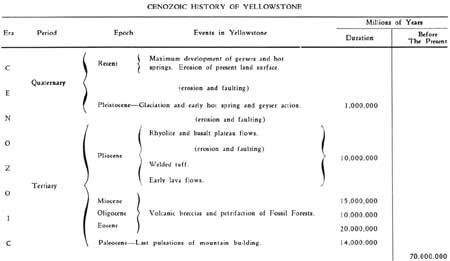|
YELLOWSTONE NATURE NOTES
|
| Vol. XXXIII |
June, 1960 |
Special Edition |
|
A GLIMPSE INTO THE PAST
Yellowstone has been described as a land of "living
geology," a place where the people can see geologic processes in
operation. Here one can enjoy the beauty of the landscape and see
dramatic evidence of the slow incessant work of water, wind, heat and
ice as each has played its part in creating, shaping and altering the
land surface. Broad open plateaus, geyser basins, canyons and waterfalls
all hemmed in by lofty snow-capped mountain peaks embracing a territory
of 3,400 square miles. To the inquisitive park visitor the important
question is, "why so much variety in this unique area?"
The answer can in part be found by travelling an
imaginary pathway back in time. From astronomic calculations and the
radiometric techniques of dating rocks the evidence now points toward a
beginning point for the earth some five billion years in the past. Rocks
formed since the inception of geologic processes on the earth are
recognized within the different eras and periods of geologic time. To
place events in their proper perspective we might imagine ourselves
travelling backwards in time and walking at such a rate that we cover
one thousand years with each pace. Two paces would take us to the dawn
of the Christian era, 35 miles to the time when the rocks now exposed on
Mt. Everts were being formed, 250 miles to the oldest sedimentary rocks
exposed on the Northeast Entrance road, and if we continued the journey
covering 1,000 years per pace we would walk in excess of 500 miles to
reach the time when the granites of Hell Roaring Mountain were being
formed.
Events that took place during these early formative
years have been deciphered in the park, but the rocks formed at these
times are largely obscured by later geologic formations. The layered
rocks of the earth's crust can be compared to the pages of a manuscript,
originally bound in proper sequence but later tattered and torn by
mountain building processes so that in places entire chapters are
missing and others are out of place.
It is the task of the geologist to decipher this
jigsaw puzzle and reconstruct past events. Events of the past 70 million
years have been most effective in determining the structural framework
and topography that we view today and for these reasons we will pick up
the sequence at this point.

FIG. 3. Cenozoic History of Yellowstone.
(click on image for an enlargement in a new window)
| 
